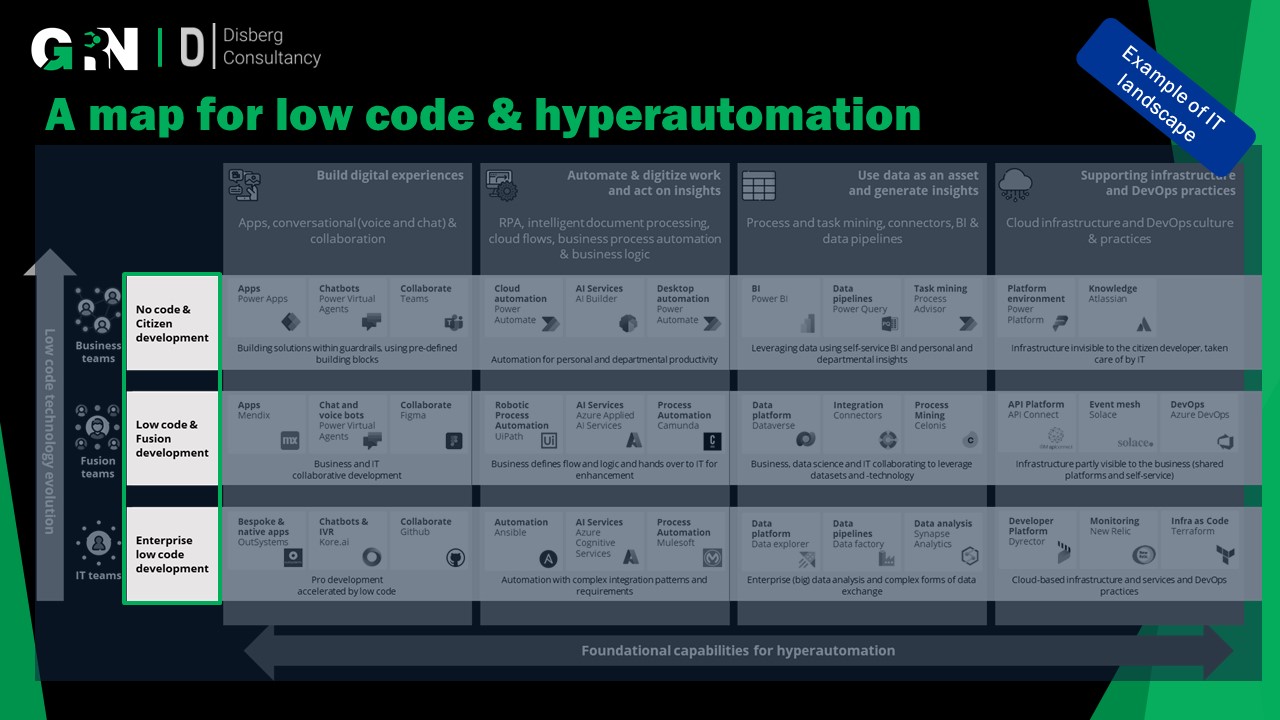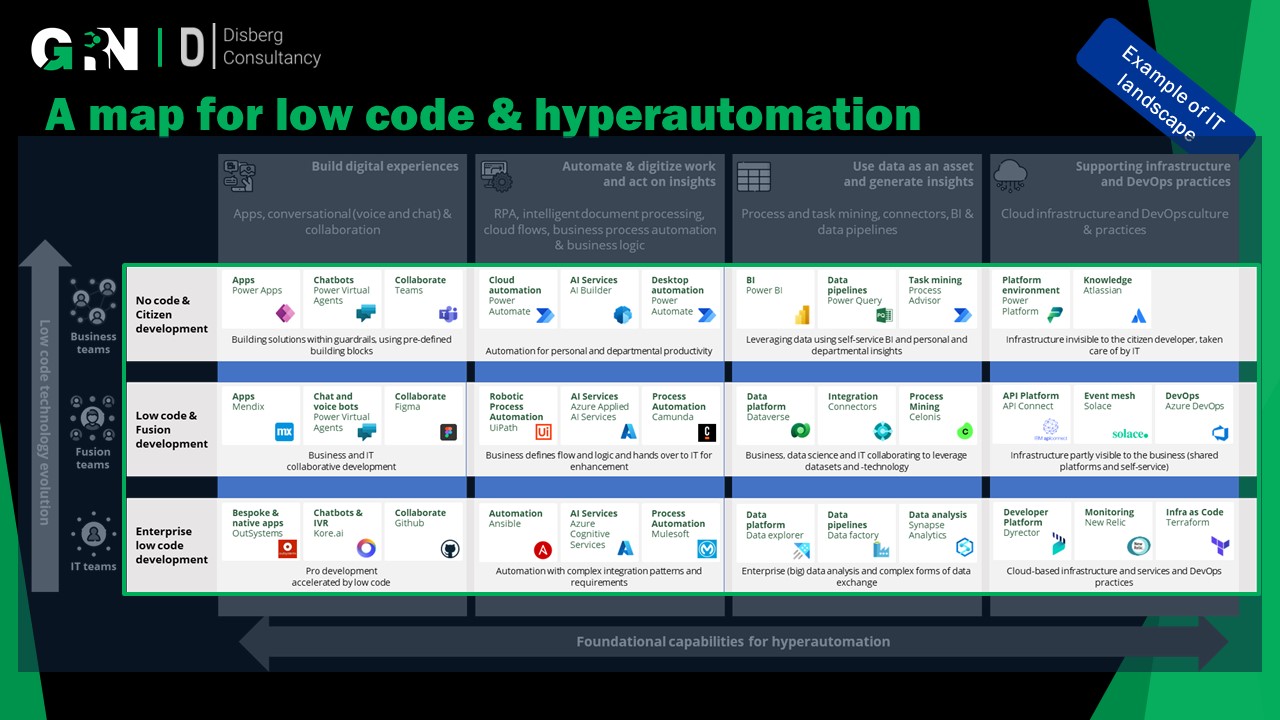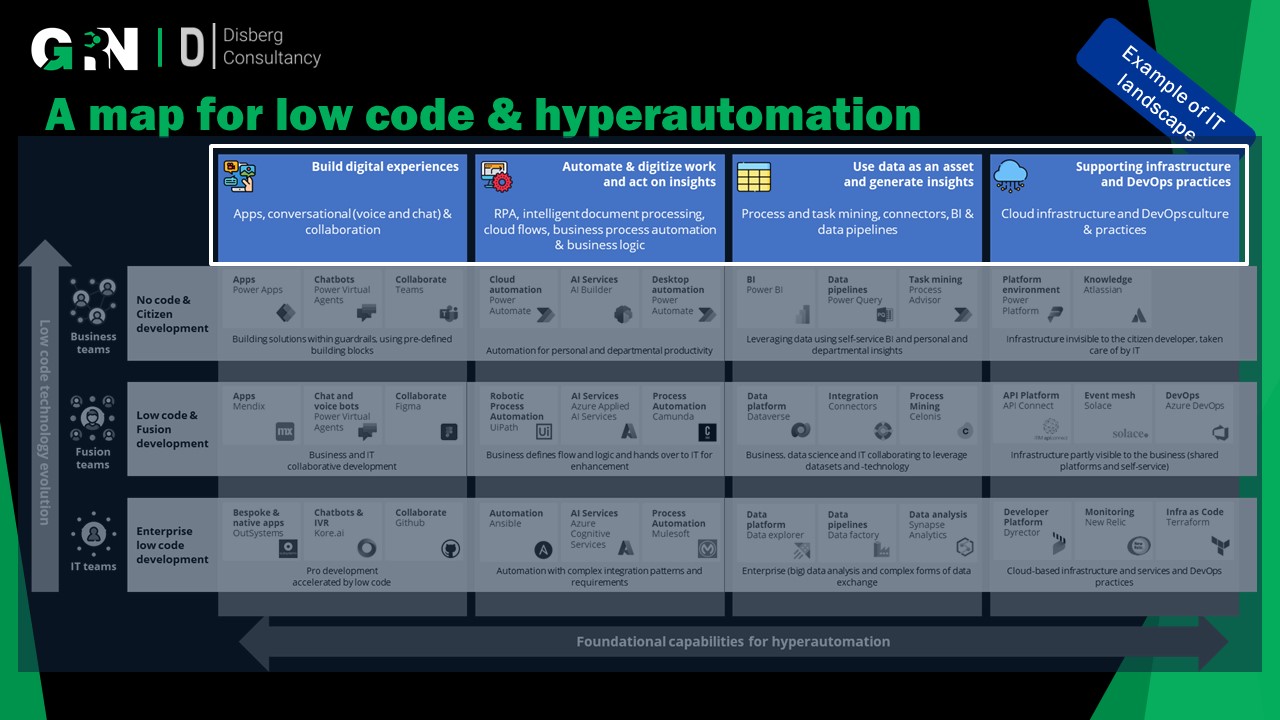Map reading

Chris Vinke, CEO & founder GRN Consultancy

Arnaud Disberg, Intelligent Automation Specialist

Ewout Masereeuw, Automation Expert
In the first part of our series, we explained why a map for low code and hyperautomation is useful. In this second part, we are going to learn how to read maps.
We discuss latitude with the different occurrences of low code and we discuss longitude with the four pillars of hyperautomation.
The latitude - No, low and enterprise low code
At latitude, we find no, low and enterprise low code - different definitions of 'low code' that often lead to speech confusion.

Spraakverwarring #1 - Nee, low en enterprise low code development
The first speech confusion comes from the fact that low code is a spectrum for developing software such as apps, chatbots and automation. To understand each other, we need to know which end of the spectrum we are talking about.
At one end of the spectrum we find no code, software development completely without programming. All parts of the software are realised with configurable, standard building blocks.
At the other end of the spectrum, we find enterprise low code. This is software development with abstraction of code by standard building blocks and models (for one or more of the user interface, logic, data and integration layers) with the freedom to apply full-fledged programming languages (such as Java, .NET or C#), libraries and frameworks.
In between is low code, software development with more emphasis on abstraction of code through standard building blocks and models (for both the user interface, logic, data and integration layer) at some points combined with scripting languages (such as Javascript).
Confusion #2 - No, low and enterprise low code platforms
The second common confusion of tongues stems from the divergence low code platforms. To further increase the chances of speech confusion, most vendors commit to one or more of the platform variants below.

No code platforms
In the no code market, we mainly find platforms for the development of simple apps, and automation for personal productiviteit (if-this-then-that automation).
No code platforms are aimed at business users who have no knowledge of software development. The platform exists to do that in good jobs to lead (and hide) and the user thus exchanges freedom for standardization.
Low code platforms
In the low code market we find the most diverse platforms for the development of, among other things apps, chatbots en (proces)automatisering.
Low code platforms are aimed at both business and IT users and often offer a simplified shape for business users.
The platform is still there to manage software development, but makes less of an effort to hide that from the user - terms such as environments, deployment and architecture layers often recur. There is also often a clear link to agile working, for example through integration with Jira or built-in functionality for backlog beheer.
In most cases, these platforms also have a "marketplace" - a place where ready-to-use, reusable components and connectors can be found.
Enterprise low code platforms
Finally, there are low code platforms that are almost entirely aimed at the IT developer – we call these enterprise low code platforms. These platforms are dedicated to the development of enterprise-grade software, with a strong emphasis on increasing developer productivity on the one hand, and robustness, scalability and flexibility on the other.
Principles and architectureof software development are strongly reflected here forward and there is a lot of focus on DevOps . And the development environment here is not split according to the type of user, but according to the type of work. For example, by providing a separate environment for designing integrationsor data models. Also, the underlying pricing and service model often focused on enterprise applications.
The Longitude - Hyperautomation
This brings us to the latitude where new applications of low code are rapidly emerging – hyperautomation.

The aim of hyperautomation is to realize (quickly) far-reaching automation and digitization (automation-by-design and digital-by-design) across the full breadth of the organization. To realize this ambition, four pillars are essential.
NB. We mention them briefly here because they will be discussed in detail in the following parts of our blog series.
Pillar 1 - Digital Experiences
A large part of hyperautomation is technology that we experience (digitally) every day. These are usually apps, but increasingly also chatbots, voicebotsin combination with platformsfocused on collaboration. And all these experiences increasingly flow seamlessly into each other.
Pillar 2 - Automation and digitization of work
The second pillar focuses on the use of technology to make our work more effective and efficient. The intention here is to automate all unnecessary manual actions. Here we find technology focused on tasks such as Robotic Process Automation (RPA ) and Intelligent Document Processing (IDP ). And technology aimed at automating various business processes such as Business Process Management (BPM), Case Management and Business Rules Management (BRM).
Pillar 3 - Generating insight
The third pillar is data. For Hyperautomation, this concerns data that we can use in the first and second pillars.
In the first pillar we use data for digital experiences. Here we find low code technology that helps unlock data, such asconnectorsand loading, transformand load (ETL) data with data pipelines.
In the second pillar, we mainly use (meta)data to find out where and how we can best automate and digitize our work. Such as using task mining and process mining.
In addition to the third pillar facilitating the use of data, the solutions in this pillar can also help to control the use of no code & low code apps within the organization. For example, a dashboard with log data from a low-code app could provide insight into who uses the app, how often, and what happens to the data after use. Once you have started your journey on our map, you can imagine that it is useful to be able to find your exact position in this way.
Pillar 4 - Infrastructure and DevOps
The fourth and final pillar is infrastructure and DevOps. Due to Hyperautomation's ambition, the use of and demands on technology continues to increase and the infrastructure must provide for this. This usually means a move to cloud infrastructure due to elasticity and pay-per-use. In addition, many of the low code platforms are already runningon cloudinfrastructure.
The infrastructure itself is also increasingly becoming low code. Services (IaaS, PaaS and SaaS) are too largely configured and the abstraction continues; from serverlessrun code to infrastructure-as-code.
DevOps stands for bringing development and management together. Good managementcontributes ensure that the IT service supports the daily operations of the business user and that the IT service is not disrupted. Inherent in the merger between development and management is that IT comes closer to the business users, just as happens with the introduction of low code. To increase the effectiveness of DevOps, principles of continuous integration, continuous deployment, feedback, monitoring, testing and delivery are brought to the fore. Further investing in these principles ultimately also promotes low code development.